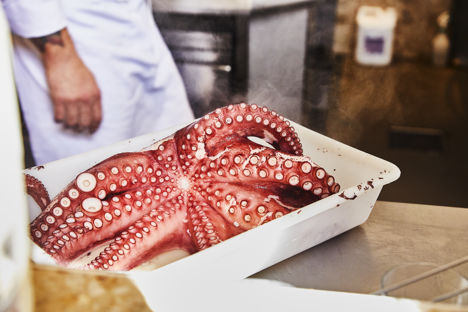Cooking octopus might seem intimidating to the under-confident chef but it isn't as complicated as you might think. It is known as polpo in Italy, pulpo in Spain and oktapodi in Greece. The Spanish consume the most octopus in Europe but their consumption still falls far behind the Japanese who are partial to tako – eaten as sushi, sashimi, tako sunomono salad or the famous street food takoyaki which are fried octopus balls.
The magnificent octopus measures up to 80cm and has eight succulent tentacles which are each a feast waiting to happen. Octopus flesh is far tougher than the flesh of other cephalopods like squid or cuttlefish so chefs worldwide have come up with different strategies for tenderising the flesh. In the Mediterranean, fishermen beat octopuses against rocks; some swear by cooking it in copper, massaging it with salt or simmering it with wine corks. Some modern chefs have even been known to bag the beast and pop it in a spin cycle in the washing machine! If handled with a little care, such extreme techniques shouldn't be necessary – gentle simmering should suffice!
How to cook octopus
If an octopus hasn't already been prepared, consult the Great British Chefs video for instructions on how to section an octopus.
The most basic way of cooking octopus is to simmer it in liquid. Fill a saucepan with salted water and bring to the boil. Add the octopus, reduce the heat immediately and simmer gently for 45–60 minutes. It's important that the water is turned down to a gentle simmer once the octopus is in the pan. Cooking it too quickly will result in a rubbery texture.
Judge the tenderness of the octopus by pushing a knife into one of the tentacles; if it easily pushes into the thickest part of the flesh, it's cooked.
Octopus contains a lot of moisture, some of which can be removed by brining or sun-drying to make the flesh more tender before grilling, barbecuing or pan-frying. Without removing some of the moisture from the flesh, the octopus will take on a chewy and rubbery texture.
This step isn't always necessary though – some methods embrace the springy texture of octopus flesh. For example, octopus can be simply marinated and enjoyed in a carpaccio style, used in sushi or deep-fried in a takoyaki batter for an enjoyable, crunchy texture.
What octopus goes with
Octopus has a very delicate flavour and dressing it with some good olive oil and seasoning it well is often enough. A popular way of introducing extra flavour is by cooking it over the hot coals of a barbecue or an ocakbasi grill, introducing a charred, smoky edge.
For inspiration, look to Mediterranean flavours which would typically get paired with seafood such as lemon, fennel, chopped parsley, tomatoes and white wine.
Get in touch
Please sign in or register to send a comment to Great British Chefs.


